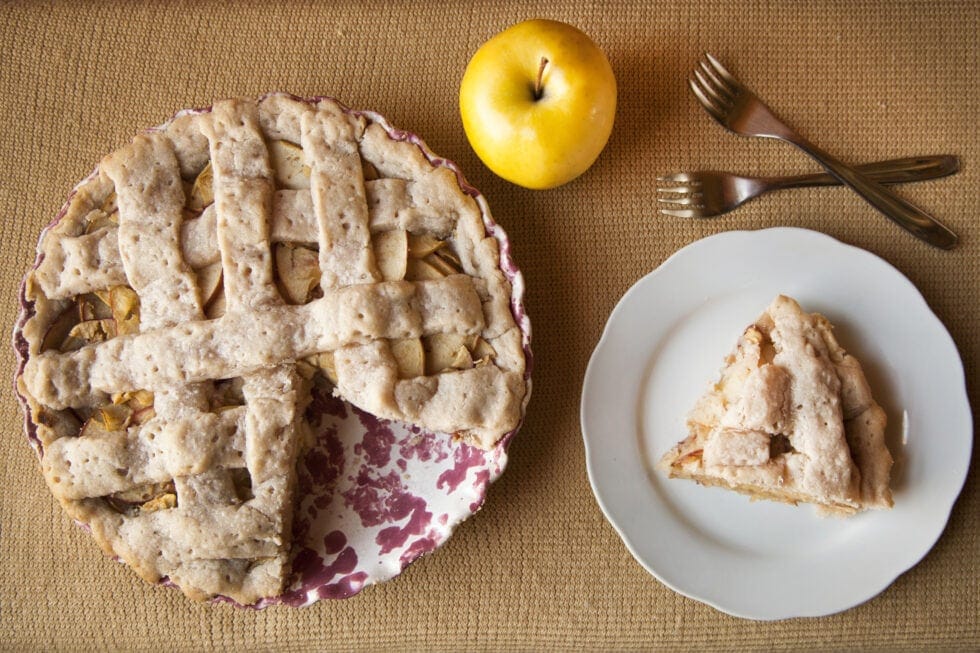
Low Histamine Apple Pie (also Low Lectin, with Medium Oxalate and Low Salicylate Options)
One of my favorite things about the Mast Cell 360 Community is how much you care and share.
You’ve graciously shared your words in the Hugs with Your Words Project.
You’ve let me know about products you’ve found that have worked great for you.
You share your tips, tricks, wins, and good humor during our Facebook Lives.
You’ve also been open with your experiences, so others know they aren’t alone.
I absolutely love the community building!
Today, I’ve got another share for you. It’s a low-histamine recipe that comes from one of our community members, Caroline.
I was delighted when Caroline sent this delicious apple pie recipe our way and gave us permission to share it. Thank you, Caroline!
When it comes to dinner time at her house, she doesn’t want anyone to feel left out…especially with desserts. She wants to make food everyone in the household can enjoy.
That’s something we strive for here at Mast Cell 360, too.
Related Article: Perfect Low Histamine Dessert Options for Stay at Home when you have Mast Cell Activation Syndrome or Histamine Intolerance
Low Histamine, Low Lectin Apple Pie Recipe
This apple pie is tasty, but that’s not all. Take a look at this.
- It’s low histamine and low lectin.
- It has no added sugars.
- Apples have some great mast cell supporting qualities.
- Cardamom spice adds taste and has health benefits.
There is a medium oxalate option and a low-salicylate option, too!
First let’s look at the benefits of apples and cardamom.
Then I’ll briefly go over some of the recipe swaps Caroline made. I hope this will give you some ideas to modify recipes on your own, too. (If you come up with a great one, I hope you’ll share!)
Then I’ve got the full recipe and directions for you.
Bonus: Our new recipes now have an easy-to-print feature!
First let’s look at the benefits of apples…including how they can support mast cells.
Health Benefits of Apples
There may be something to that old saying, “An apple a day keeps the doctor away!”
Apples have been shown to have properties that support good health. You definitely want to start with organic apples, though! Here’s why.
Pesticides and Apples
Apples are on the Environmental Working Group’s Dirty Dozen Food List. That means conventionally grown apples are high in pesticide residue.
Tip: When you buy apples, make sure to get organic! When you look at produce, make sure the 5-digit PLU number starts with a 9.
Pesticides can stick to foods with soft skins like strawberries. The wax coating on some produce, like apples, can also trap pesticide residue.
Rinsing your produce can reduce bacteria and some pesticide residue. You can’t completely wash off pesticides, though. This is because they can get into the flesh of the produce.
How does this happen? Some pesticides are systemic. That means they get absorbed from the soil by the plant’s roots and spread throughout the plant…including into the flesh or the fruits and vegetables.
Did you know: Pesticides are the broad term for herbicides (weeds), insecticides (insects), fungicides (mold), and disinfectants (bacteria).
Certain pesticides like glyphosate have been shown to be mast cell triggers. Glyphosate is one of the top herbicides used on apples. Glyphosate is the active ingredient in RoundUp.
In animal studies, glyphosate has been shown to have potentially severe effects on the immune system and cause inflammation.
This is why it’s important to start with organic apples.
Now let’s look at the benefits you can get from apples. There are so many!
How Apples May Support Your Health
Studies have linked eating apples with numerous benefits. Here’s where some of those benefits stem from.
Apples are a natural food-based source of:
- Fiber
- Quercetin
- Vitamin C
Fiber
You’ve very likely heard about some of fiber’s benefits already. There are a lot of commercial products out there made to help you get more fiber into your diet.
But you can get fiber naturally from eating apples (among other fruits and vegetables.)
Fiber may help:
- strengthen the immune system
- increase the production of anti-inflammatory proteins
- normalize bowel movements in diarrhea or constipation
- control blood sugar
- reduce blood pressure
Supporting your immune system is good news all around. And remember…mast cells are an important part of your immune system.
Speaking of mast cells, you probably already know that with Mast Cell Activation Syndrome, your mast cells are over-responding. More response can mean more histamine release. And more histamine release equals more inflammation.
Inflammation can aid in the healing process. However, chronic inflammation can lead to gut issues, skin irritations, joint pain and so many more problems.
Fiber has been shown to help reduce your inflammatory response. That’s going to help combat some of that excess mast cell inflammation.
Here’s another way apples can support your health – Quercetin.
Quercetin
Quercetin is found in some fruits and vegetables. Apples are particularly rich with quercetin. Quercetin is found in apple skins, so you’ll want to keep those on to be sure you are getting the benefits!
Quercetin has been shown to have:
- antioxidant properties
- anti-inflammatory properties
- mast cell stabilizing properties
If you’d like to learn more about quercetin, check out the Top 8 Mast Cell Supporting Supplements Master Class.
If you have Mast Cell Activation Syndrome or Histamine Intolerance, here’s another way apples can support you – Vitamin C.
Vitamin C
Vitamin C has been shown to have some great benefits when it comes to Histamine Intolerance! It
- naturally lowers histamine by helping the body produce more diamine oxidase (DAO) — a histamine-degrading enzyme
- is an antioxidant vitamin that can support the reduction of histamine-induced inflammation in the body
That’s a lot of great things coming your way from this pie! How often can you say pie supports your health? 😊
Tip: Do you have salicylate intolerance Peel the apples and choose golden or red delicious apples to make this low salicylate.
Next let’s look at one of my favorite spices: cardamom.
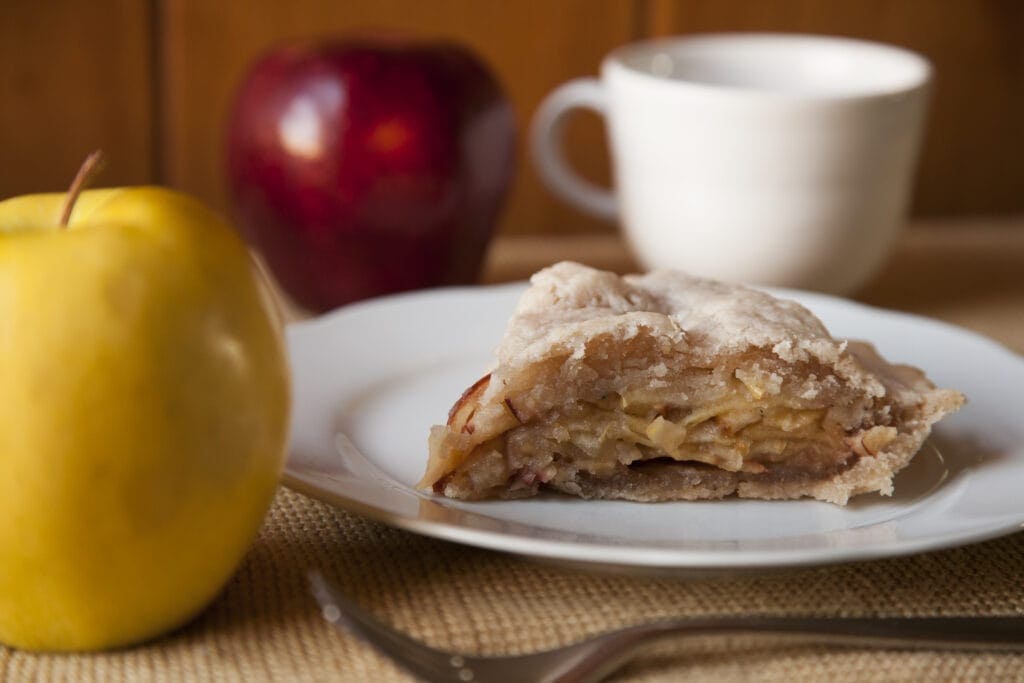
Health Benefits of Cardamom
I love cardamom for the warm, earthy flavors it adds to any dish. It’s a little bit spicy like cinnamon. But it also has subtle floral and citrus notes. Some people even describe it as piney and peppery. It really is complex and versatile!
Apple pies are often complemented with spices like cinnamon, cloves, and all-spice. It is a much-loved pairing! Unfortunately, cinnamon, cloves, and all-spice are histamine liberators.
Some of my very sensitive clients with Mast Cell Activation Syndrome have flares with the smell of cinnamon. For some of them, it made them feel nauseous. A few others have reported trouble breathing.
Cardamom is a great substitute for cinnamon. It has the same rich and full flavor profile that is a nice sub for the more traditional apple pie spices.
In addition to robust flavor, here are some additional benefits to cardamom.
Cardamom has been shown in studies to:
- reduce blood pressure
- increase antioxidant status by 90% in human studies
- have anti-inflammatory properties
I like to round out the flavor here with ginger and camu camu. They both bring a flavor profile that works really well with apples and cardamom.
Ginger and camu camu have also been shown in studies to have anti-inflammatory properties. Plus, camu camu is a good source of Vitamin C.
In terms of flavor, camu camu adds light citrus notes. Ginger adds another layer of warm spice.
Salicylate Intolerance?
You’ll want to skip cardamom, ginger, and camu camu.
You can get playful with any recipe in terms of spices. I encourage you to experiment and see what works for you.
Here’s one idea you can try to add more flavor if you have salicylate intolerance.
Chamomile tea is low salicylate. When making the dough for the crust, use room temperature chamomile tea in place of water.
Additionally, you can let the apples marinate in chamomile tea for about 10 minutes after they’ve been cut and before you add any additional ingredients.
Once they’ve marinated, drain the liquid. Proceed with the recipe as indicated. (This will add subtle flavor notes. Apples will still be your star ingredient.)
What ingredients support your health and make your tastebuds sing?
Caroline, who provided this apple pie recipe, did an outstanding job making swaps that would eliminate some big mast cell triggers and accommodate a low histamine diet.
Keep reading for a few tips on how you can make swaps to revamp your recipes, too!
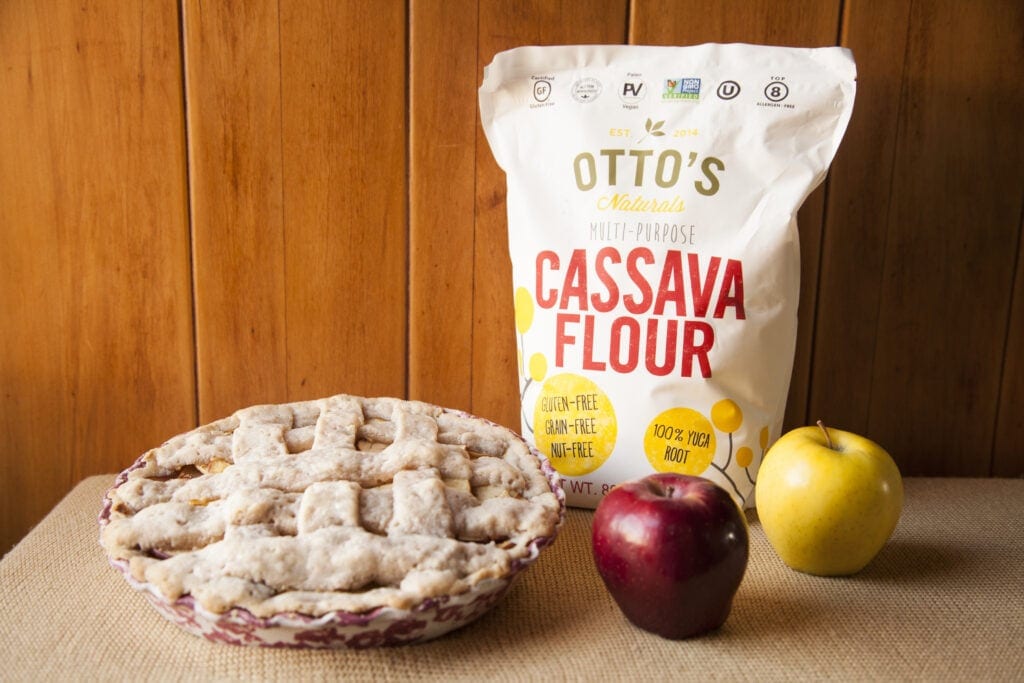
Mast Cell and Low Histamine Recipe Swaps
Dessert recipes can present a few problems for those of us with Histamine Intolerance and Mast Cell Activation Syndrome. You’ll find gluten, sugar, and dairy in many baked goods.
Here’s a brief look at why they pose potential problems and what you can do about it in your recipes.
Wheat Substitutes
Wheat flour is problematic for some because of the gluten and lectin content. Both of those things can potentially trigger mast cells if you have gluten or lectin sensitivity.
To get around that, I’ve found that cassava flour works as a great substitute for a lot of baked goods. That’s what you’ll use in this pie recipe.
Otto’s Cassava Flour is lectin-free, gluten-free, and lower in oxalates than other brands I’ve tried. It’s also made without fermentation. That’s why Otto’s is my preferred brand.
Here are some things to know about oxalates and cassava flour.
It’s not always a 1:1 swap for wheat flour. If you’re swapping it in other recipes, just check the Otto’s Cassava Flour package for details on swapping.
And here’s what you need to know about cassava flour and oxalates.
With oxalates, the amount you eat can be a determining factor when considering if a serving is high, medium, or low oxalate. At ¼ cup serving, Otto’s was tested as high oxalate. (Still lower than other brands.)
However, if the cassava flour in your serving comes to 1/8 cup or less, that would be considered moderate.
If you want to keep this apple pie recipe at a moderate oxalate level, you’ll need to leave off the top crust. What you’ll have instead is a delicious apple tart. Tarts typically have a bottom crust and not a top crust. It’s equally tasty and satisfying!
If you have very significant oxalate sensitivity, this might not be the recipe to try just yet.
Next, let’s look at sugar.
Sugar Substitutes
Baked goods are called sweets for a reason. They are full of sugar!
Sugar isn’t your friend, though, if you have Histamine Intolerance or Mast Cell Activation Syndrome.
In animal studies, increased sugar has been shown to signal to your body to pump out more histamine.
Basically, what that means is this: eating sugar = higher histamine levels.
You end up with an over-abundance of this inflammatory mediator in your body. And this can trigger your mast cells considerably!
But there are ways you can sweeten your dishes without affecting your blood sugar levels and without triggering histamine release.
Monk Fruit extract is a great substitute for sugar.
I really like using monk fruit in baking because it has a bit of a caramel or brown sugar flavor. And it’s less bitter than stevia.
TIP: Don’t use just any Monk Fruit!
I’ve tried several brands now. Most of them tasted pretty bad.
I highly recommend you use the Smart Monk 100% Monk Fruit Powder. The taste of some monk fruit extracts reminds me of a diet soda. It tastes like chemicals and leaves a yucky aftertaste in your mouth. Smart Monk really does have the best taste!
Now you’ve got a good base for making swaps for wheat flour and sugar. Last, let’s look at what you can consider in place of butter or vegetable oils.
Coconut Oil
Butter is commonly used for pie crusts. But some people with dairy sensitivities have trouble with butter because it contains milk proteins called casein.
This recipe uses coconut oil for the crust. Coconut oil is a healthy form of saturated fat. Contrary to popular belief, healthy saturated fats are essential to brain health!
The best brand of coconut oil I’ve tried is Dr. Bronner’s. The whole kernel brown one has a stronger coconut flavor. The white kernel one is much milder. You can use the one you prefer.
If you can’t use coconut oil, though, you could use ghee instead. Ghee doesn’t contain casein. Many people do well with it but use what works best for you.
I’d recommend you not use vegetable oils like canola and corn oil, though. These contain high levels of inflammatory fats that aren’t the best for your mast cells.
Caroline chose to use coconut oil for this recipe.
Speaking of the pie recipe…here it is in our new, easy to print format. I hope this new feature will allow you to print out recipes and keep them in a binder for easy reference.
You’ll have your own low-histamine cookbook to refer to at any time! Enjoy!
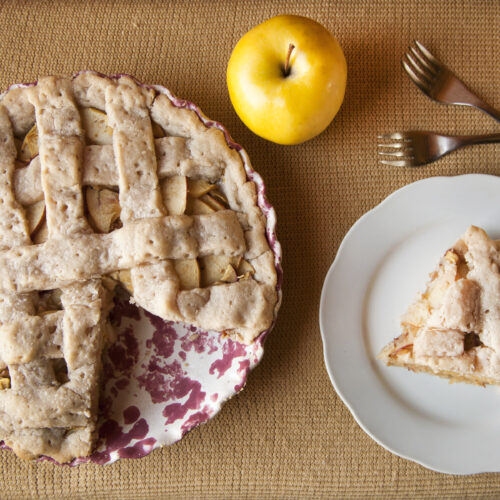
Low Histamine Apple Pie Recipe
Equipment
- Silicone Mat (optional)
- Foil
- Knife (if making a lattice top)
Ingredients
Crust
- 2 cups Otto's Cassava Flour 1 cup for medium oxalate tart
- ¾ teaspoon Redmond Real Salt ⅜ teaspoon for medium oxalate tart
- 1 cup Dr. Bronner's Coconut Oil ½ cup for medium oxalate tart
- 1⅛ cup Filtered Water or Chamomile Tea ½ cup plus 1 teaspoon for medium oxalate tart
Option: use chamomile tea instead of water for low salicylate option
Filling
- 3 Organic Apples Peel for low salicylate option
Option: marinate for about 10 minutes in chamomile tea for low salicylate option
- 1 teaspoon Cardamom Omit for low salicylate option
- ¾ teaspoon Smart Monk 100% Pure Monk Fruit Powder
- 1 tablespoon Otto's Cassava Flour
- 1 teaspoon Ginger (grated) Omit for low salicylate option
- 1 teaspoon Camu Camu Omit for low salicylate option
- 2 cups Chamomile Tea Optional for low salicylate option
Instructions
Make the Dough
- Preheat oven to 425°F
- We provided measurements for both the pie and the tart version of the crust ingredients. If you are making the medium oxalate tart, make sure you've used the halved measurements since you'll only need one crust.
- Mix the cassava, salt, water (or tea), and coconut oil in a large bowl. Use a pastry cutter to mix the dough together. (You can use a spoon, but I find the pastry cutter incorporates the coconut oil and flower together better.) When it begins coming together, you can finish mixing the ingredients by kneading the dough with your hands. Work the dough until it becomes easy to divide without crumbling apart.
- Divide the dough into 2 balls and put in the fridge to rest. (If you are making the medium oxalate tart, you'll only have 1 ball of dough for your bottom crust.)
Make the Filling
- Core the apples. I like using an apple corer. It’s quick and easy.
- Use a mandoline to thinly slice the apples. You can use a knife, but a mandoline makes your work a lot easier.
- Put apples in a large mixing bowl.
- If you are making the low salicylate version and want to add flavor by marinating apples in chamomile tea, pour room temperature tea over apples and let them soak for about 10 minutes.
- Grate the ginger with a microplane grater. (Skip for low salicylate version.)
- If using cardamom pods: the shell is the outer paper-y part. The seeds are inside. They are small and black. Separate the shell from the seeds. To do this, put the pods in a mortar and loosely smash with the pestle to open the pods. From here, manually separate the shells from the seeds. Throw away the shells and leave the seeds in the mortar. When all shells have been discarded, use the pestle on the seeds to grind them more finely. (Skip for low salicylate version.)
- If you are marinating the apples, drain the liquid, add cassava flour, mix by hand.
- Add the ginger, cardamom, camu camu and monk fruit and cassava flour (thickener) to the apples and mix thoroughly by hand. (Skip for low salicylate version.)
Assemble and Bake
- Grease 1 pie pan with coconut oil.
- Take the dough balls out of the fridge. When you press on the dough ball, it should hold together. If it crumbles, add a little bit more water until it holds together.
- One at a time, place each dough ball between two sheets of parchment paper and roll each one flat. (Or you can use a silicone mat.) This will form your bottom and top crusts.
- Put one of the flattened dough rolls on the bottom of the pie pan. Press the dough gently against the bottom and sides of the pie pan to form the bottom crust.
- Put the apple mixture on top.
- Cover with the remaining flattened dough roll. Pinch together the top and bottom dough at the seams. You can cut this into strips to make a lattice top as an option.(Omit top crust for medium oxalate tart.)
- Bake in the oven for 15 minutes.
- After 15 minutes, take out the pie and loosely cover it with an oven proof lid. You can also use foil, but don’t let it touch the pie. Form a foil dome over the top.
- Return the pie to the oven and bake for an additional 20 minutes.
- Remove the pie from the oven and let it cool slightly before eating.
Notes
Oxalate information is based on 1/8 of the pie.
Nutrition
I’ve heard of people adding ice cream or American cheese to the top of their apple pie. (Both high histamine.) While this recipe is good without any toppings, I’m curious to know:
What low histamine food toppers do you like to add to your apple pie recipe?
More Low Histamine Desserts
- Low FODMAP Vanilla Ice Cream – Low Lectin, Low Oxalate
- Mango Ice Cream – Low Lectin, Low Oxalate
- White Chocolate Cookie Dough – Low Lectin and Medium Oxalate
- Macadamia Nut Butter – Low FODMAP, Low Lectin, and Low Oxalate
- Blueberry Cassava Flour Muffins – Low Lectin and Medium Oxalate and Low Salicylate Options
- 6 Layer Cranberry Trifle – Low Lectin and Low Oxalate
- Pecan Clusters – Low Lectin and Medium Oxalate
- Ginger Cardamom Breakfast Rolls – Low Lectin, Moderate Oxalate, and Moderate FODMAP
*Some links in this website are affiliate links, which means Mast Cell 360 may make a very small commission if you purchase through the link. It never costs you any more to purchase through the links, and we try to find the best deals we can. We only recommend products that we love and use personally or use in the Mast Cell 360 practice. Any commissions help support the newsletter, website, and ongoing research so Mast Cell 360 can continue to offer you free tips, recipes, and info. Thank you for your support!
References
- Anogeianaki, A., Castellani, M. L., Tripodi, D., Toniato, E., De Lutiis, M. A., Conti, F., Felaco, P., Fulcheri, M., Theoharides, T. C., Galzio, R., Caraffa, A., Antinolfi, P., Cuccurullo, C., Ciampoli, C., Felaco, M., Cerulli, G., Pandolfi, F., Sabatino, G., Neri, G., & Shaik-Dasthagirisaheb, Y. B. (2010). Vitamins and mast cells. International journal of immunopathology and pharmacology, 23(4), 991–996. https://doi.org/10.1177/039463201002300403
- Consumer Reports. (2015, March 19). Pesticides in Produce – Consumer Reports. Https://Www.Consumerreports.Org/Cro/Produce0515. Retrieved January 22, 2022, from https://www.consumerreports.org/cro/health/natural-health/pesticides/index.htm#:%7E:text=Pesticides%20can%20stick%20to%20soft%20skins%2C%20and%20the,vegetable%20flesh%20so%20they%20can%E2%80%99t%20be%20washed%20off
- Environmental Working Group. (2021). #DirtyDozen Fruits and Vegetables with the Most Pesticides – @EWG’s Shopper’s Guide to Pesticides in ProduceTM. EWG. Retrieved January 20, 2022, from https://www.ewg.org/foodnews/dirty-dozen.php
- Grzanna, R., Lindmark, L., & Frondoza, C. G. (2005). Ginger–an herbal medicinal product with broad anti-inflammatory actions. Journal of medicinal food, 8(2), 125–132. https://doi.org/10.1089/jmf.2005.8.125
- Harvard T.H. Chan School of Public Health. (2021, October 5). Apples. The Nutrition Source. Retrieved January 22, 2022, from https://www.hsph.harvard.edu/nutritionsource/food-features/apples/
- Jarisch, R., Weyer, D., Ehlert, E., Koch, C. H., Pinkowski, E., Jung, P., . . . Koch, A. (n.d.). Impact of oral vitamin C on histamine levels and seasickness. https://www.ncbi.nlm.nih.gov/pubmed/25095772
- Li, Y., Yao, J., Han, C., Yang, J., Chaudhry, M. T., Wang, S., Liu, H., & Yin, Y. (2016). Quercetin, Inflammation and Immunity. Nutrients, 8(3), 167. https://doi.org/10.3390/nu8030167
- Ma, Y., Hébert, J. R., Li, W., Bertone-Johnson, E. R., Olendzki, B., Pagoto, S. L., Tinker, L., Rosal, M. C., Ockene, I. S., Ockene, J. K., Griffith, J. A., & Liu, S. (2008). Association between dietary fiber and markers of systemic inflammation in the Women’s Health Initiative Observational Study. Nutrition (Burbank, Los Angeles County, Calif.), 24(10), 941–949. https://doi.org/10.1016/j.nut.2008.04.005
- Mayo Clinic Staff. (2021, January 6). Dietary fiber: Essential for a healthy diet. Mayo Clinic. Retrieved January 21, 2022, from https://www.mayoclinic.org/healthy-lifestyle/nutrition-and-healthy-eating/in-depth/fiber/art-20043983?reDate=22012022
- Mohamed, H. I., El-Beltagi, H. S., Jain, S. M., & Al-Khayri, M. (2021, January 1). Date palm (Phoenix dactylifera L.) secondary metabolites: Bioactivity and pharmaceutical potential. ScienceDirect. Retrieved January 21, 2022, from https://www.sciencedirect.com/science/article/pii/B9780128241097000182
- National Agricultural Statistics Service. (2018, July). 2017 Agricultural Chemical Use Fruit Crops (No. 2018–6). USDA. https://www.nass.usda.gov/Surveys/Guide_to_NASS_Surveys/Chemical_Use/2017_Fruits/ChemUseHighlights_Fruit_2018.pdf
- Peillex, C., & Pelletier, M. (2020). The impact and toxicity of glyphosate and glyphosate-based herbicides on health and immunity. Journal of immunotoxicology, 17(1), 163–174. https://doi.org/10.1080/1547691X.2020.1804492
- Souissi, M., Azelmat, J., Chaieb, K., & Grenier, D. (2020, February 1). Antibacterial and anti-inflammatory activities of cardamom (Elettaria cardamomum) extracts: Potential therapeutic benefits for periodontal infections. ScienceDirect. Retrieved January 21, 2022, from https://www.sciencedirect.com/science/article/abs/pii/S1075996419301490
- Thakur, M., Singh, K., & Khedkar, R. (2020, January 1). Phytochemicals: Extraction process, safety assessment, toxicological evaluations, and regulatory issues. ScienceDirect. Retrieved January 20, 2022, from https://www.sciencedirect.com/science/article/pii/B9780128185933000117
- University of Illinois at Urbana-Champaign. (2010, March 17). An apple a day? Study shows soluble fiber boosts immune system. ScienceDaily. Retrieved January 22, 2022 from www.sciencedaily.com/releases/2010/03/100302171531.htm
- Verma, S. K., Jain, V., & Katewa, S. S. (2009). Blood pressure lowering, fibrinolysis enhancing and antioxidant activities of cardamom (Elettaria cardamomum). Indian journal of biochemistry & biophysics, 46(6), 503–506.
- Wang, K. Y., Tanimoto, A., Yamada, S., Guo, X., Ding, Y., Watanabe, T., Watanabe, T., Kohno, K., Hirano, K., Tsukada, H., & Sasaguri, Y. (2010). Histamine regulation in glucose and lipid metabolism via histamine receptors: model for nonalcoholic steatohepatitis in mice. The American journal of pathology, 177(2), 713–723. https://doi.org/10.2353/ajpath.2010.091198
- Yazawa, K., Suga, K., Honma, A., Shirosaki, M., & Koyama, T. (2011). Anti-inflammatory effects of seeds of the tropical fruit camu-camu (Myrciaria dubia). Journal of nutritional science and vitaminology, 57(1), 104–107. https://doi.org/10.3177/jnsv.57.104


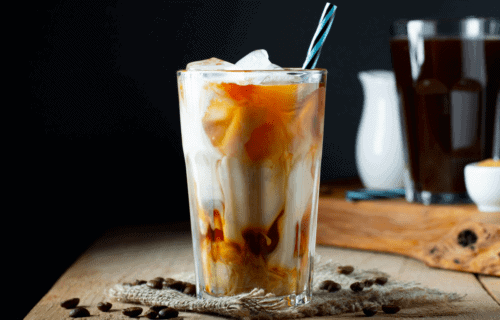
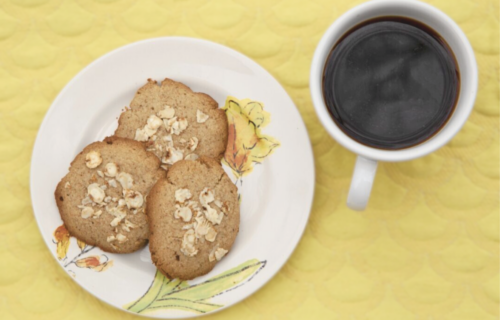
Is this pie safe from histamine forming in the refrigerator for a few days or does it have to be frozen? My freezer broke and won’t be fixed until the part comes in. 🙁
Hi Nikki, unfortunately it would not be completely safe from forming histamines in the refrigerator, but remember histamines intolerance depends on how full your histamine load is at any given time, so depending on that for you personally it might be ok!